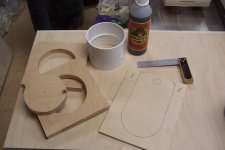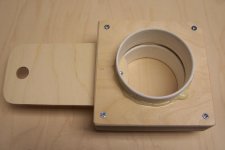Hello Everyone,
I have completed my CV installation about 3 months ago and am now getting around to getting some pics posted in the gallery (http://www.gallery2.clearvuecyclones.com/v/CV1800+and+CVMax/SGI+Dave/) and a note on the forum.
I am impressed with the performance of the CV. I have numerous bends in my ducting set up due to the layout of my shop space (and probably poor planning on my part). Nonetheless, it does very well. My reference point is my previous DC which was a bare WoodSucker cyclone I bought from Ed Morgano 10+ years ago. At that time I was upgrading from a 2 hp Jet bag-type DC, so I simply mounted the Jet fan/motor on top of the Woodsucker. It worked fairly well. At the time I thought it worked really good, but now that I have a CVC with 5 hp...WOW, it does make a difference to have the higher hp!
In my previous set up, the cyclone exhausted into a box with 2 filters, mounted end-to-end with OUT to IN filtration. I had a high ceiling (13') in that shop so the cyclone and filter box where mounted high to conserve floor space. Anyway, my faulty design of THAT filter box made it hard to clean the filters. The filters where not removable and cleaning was through access hatches; alas, it was so high-mounted, I needed a 10' step ladder to get to it. Yikes! For my new shop space I wanted the filters at floor level AND in an enclosure which allows easy removal for cleaning. You can see what I came up with in my gallery pics.
The filter box is connected to the CVC via HVAC ducting, flexible 8" with insulation. I gleaned from this forum that the insulated ducting for cyclone exhaust was worthwhile for noise reduction.
I have a sound meter but have not taken it to the shop. I will post db measurements....soon...maybe....
Work Safe!
/david
I have completed my CV installation about 3 months ago and am now getting around to getting some pics posted in the gallery (http://www.gallery2.clearvuecyclones.com/v/CV1800+and+CVMax/SGI+Dave/) and a note on the forum.
I am impressed with the performance of the CV. I have numerous bends in my ducting set up due to the layout of my shop space (and probably poor planning on my part). Nonetheless, it does very well. My reference point is my previous DC which was a bare WoodSucker cyclone I bought from Ed Morgano 10+ years ago. At that time I was upgrading from a 2 hp Jet bag-type DC, so I simply mounted the Jet fan/motor on top of the Woodsucker. It worked fairly well. At the time I thought it worked really good, but now that I have a CVC with 5 hp...WOW, it does make a difference to have the higher hp!
In my previous set up, the cyclone exhausted into a box with 2 filters, mounted end-to-end with OUT to IN filtration. I had a high ceiling (13') in that shop so the cyclone and filter box where mounted high to conserve floor space. Anyway, my faulty design of THAT filter box made it hard to clean the filters. The filters where not removable and cleaning was through access hatches; alas, it was so high-mounted, I needed a 10' step ladder to get to it. Yikes! For my new shop space I wanted the filters at floor level AND in an enclosure which allows easy removal for cleaning. You can see what I came up with in my gallery pics.
The filter box is connected to the CVC via HVAC ducting, flexible 8" with insulation. I gleaned from this forum that the insulated ducting for cyclone exhaust was worthwhile for noise reduction.
I have a sound meter but have not taken it to the shop. I will post db measurements....soon...maybe....
Work Safe!
/david




